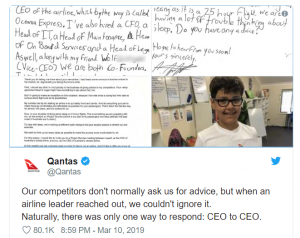This recent article in Forbes caught our attention because it neatly sums up some of the biggest differences between B2B and B2C marketing. Unlike many B2C decisions – which are based on emotion, preference or impulse – B2B decisions are practical, thoughtful and undergirded by data, or at least they should be. Among the implications of that:
- Know the who, the why and the multiple decision makers in the chain;
- Tell how you will make the business better;
- Sell solutions, not features; and
- Use personas and create a path to the purchase
Paul co-wrote a book a while back called Social Marketing to the Business Customer that touched on some of these points, and you might want to pick up a copy as they are still relevant.
One suggestion is to build an emotional attachment to the product, which isn’t always easy to do in B2B scenarios. However, buyers have a lot on the line, and that can give you an emotional connection.
ChiefMarketer.com tells how Caterpillar did that. Just because you sell big tractors doesn’t mean you can’t create a story that resonates with the community. People who drive tractors care about their work, so Caterpillar focused on the pride they take in what they do. Decisions aren’t just about features.
This story reminded us of this brilliant video Volvo produced several years ago to promote its tractor trailers. The appearance of Van Damme is unexpected, powerful and memorable, as evidenced by its 93 million views and the fact that we both recalled it eight years later.
Finally, one item that has nothing to do with trucks is the spillback a year after the implementation of the EU’s General Data Protection Regulation. A piece in eConsultancy talks about how the rules have benefited B2B marketers by helping them weed out bad practices, improve lead quality and better focus their companies’ marketing efforts.
Listen to our podcast here:
 For technology companies, the conventional wisdom is wrong when it comes to pitching a conference or webinar session. Instead of having your CMO or other C-suite executive tell your story, trust the technical people in your shop. Your audiences will thank you for it.
For technology companies, the conventional wisdom is wrong when it comes to pitching a conference or webinar session. Instead of having your CMO or other C-suite executive tell your story, trust the technical people in your shop. Your audiences will thank you for it. Paul and I first met Jen McClure (left) more than a decade ago and shortly after she founded the Society for New Communications Research (SNCR) in 2005. Jen, who has been a frequent guest on
Paul and I first met Jen McClure (left) more than a decade ago and shortly after she founded the Society for New Communications Research (SNCR) in 2005. Jen, who has been a frequent guest on 
 Paul Gillin and I are old hands at email newsletters. Paul had his own for several years and has produced several for his clients. I currently publish two:
Paul Gillin and I are old hands at email newsletters. Paul had his own for several years and has produced several for his clients. I currently publish two: 

 We also found this piece on Marketing Week
We also found this piece on Marketing Week

